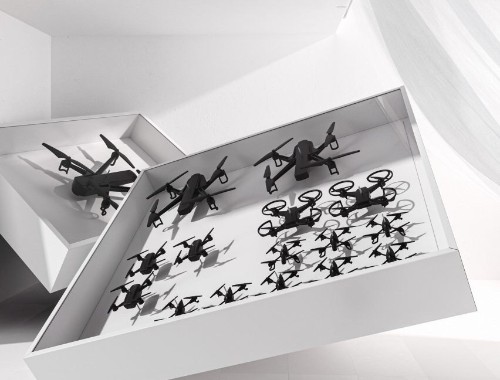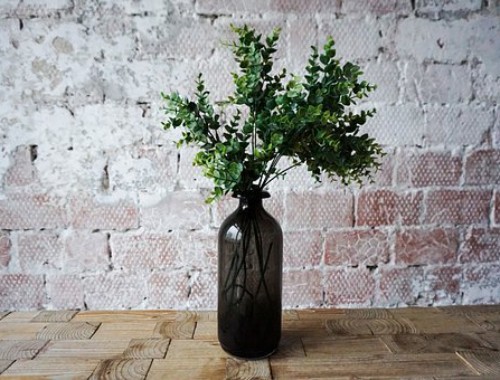How IKEA Got Cööl: The Furniture Giant's Rise from Boring Basics to Hyped Homegoods
The Swedish behemoth is dropping collections with the swagger of Supreme these days—and we can't help snapping them up.
I’m starting to develop a crush on Ikea.
It started with a vase, which lingered around my desk at Esquire after a photoshoot and which I eventually gifted to a friend who had become equally obsessed with it. Before the appearance of the vase, I had associated Ikea with cultural references that deemed it boring at best and uncool at worst: the scene in Fight Club where Edward Norton’s narrator, driven to numb insanity by consumerism, describes himself as a “slave to the Ikea nesting instinct,” or the catastrophic 30 Rock episode where Liz and her crunchy boyfriend spend a hellish Valentine’s Day shopping for an Ikea dining room table. Ikea was where relationships went to die, where you got placeholder furniture until you could afford something better. It was, as the New Yorker put it in 2011, “Legos for grownups.” But this vase was something else. I was, as the kids say, shook.
The vase, elusively titled “Vase, mushroom,” is part of Föremål, a collection of gloriously and deliberately ugly ceramics crafted by Swedish artist Per B Sundberg. Its debut is just one in a string of jarring moves made by Ikea in recent years that have shocked anyone paying attention to the global Ikea machine, whose current reach comprises 313 stores worldwide, including in countries like China and India where other mass retailers have struggled to stay solvent. But Föremål and the rest of Ikea's 2018 releases are simply the next steps for an ever-evolving brand that consistently—and expertly—folds pieces of the cultural zeitgeist into its personality. They’re proof that Ikea sneakily got cool.
Most laymen would track the explosion of new Ikea to the spring of 2017, when Demna Gvasalia sent a $2,000 dupe of the brand’s iconic Frakta bag down the Balenciaga runway, setting off a flurry of scrutiny and trendy Ikea reboots made by Instagram users. But it took a little more than a rogue fashion designer to land the company responsible for popularizing Swedish meatballs a slate of collaborations with everyone from streetwear king Virgil Abloh to NASA. It took someone like Marcus Engman, who became Ikea's head of design in 2012 and was tasked with rethinking its product development and pushing its creative edge. “They asked me to put Ikea and design on the map again,” says Engman, who recently retired from the furniture giant to start a creative collective called Skewed.
Engman, a homegrown Ikea fan whose father designed the Klippan loveseat in 1979 and who himself started pushing trolleys in the cavernous halls of Ikea’s first store in Älmhult, Sweden, at the age of 16, took this mission and ran with it, ramping up communication between divisions and using transparency with customers to try and reframe the brand’s image—to move it away from its association with cheap stuff.
“If we just share how hard it is to do Ikea products and how much effort we put into it, people understand the value,” Engman explains. “The aim was to get a better understanding for the quality.”
But Engman’s real magnum opus was the introduction of limited collections and collaborations. In 1995, as a member of the product development team, he helped design Ikea’s first PS collection (short for Post Scriptum), which embellished its original range with products that skewed more trend-aware and less Scandi-chic, like a graphic rug overlain with abstract patterns and a series of mod textiles. From then on, a new PS collection was released every three years, each serving as an opportunity for Ikea to flex its zeitgeist muscles, showing it could do more than pared-back basics.
By the time Engman took on the head design role, returning from a 12-year stint running his own retail agency, Ikea had grown to almost twice its size. But he cared more about experimentation than expansion. While Ikea had always sought to highlight bright design stars, the brains behind its designs were largely Northern European, sometimes known by industry insiders but rarely recognizable to Ikea customers, especially those abroad. Engman marks Ikea’s 2015 collaboration with British designer Ilse Crawford, a naturals-heavy assortment of furniture and décor, as a key turning point in testing its limitations. “Ilse, at the time, was famous for doing super-expensive hotels and lounges,” he says—a far cry from Ikea’s typical fare.
A month after debuting Crawford’s line, Ikea held its first runway show at Milan Fashion Week, previewing a whimsically garish collection dreamed up by British designer Katie Eary, who’d spent the past few years palling around with Kanye West while she helped him with his pre-Yeezy foray into menswear. Ikea’s creative leader, Henrik Most, worked closely with Eary to imprint her psychedelic style onto products for the home. Instead of trying to find the near-nonexistent middle ground between the two brands, Most gave Eary full reign. Spearheading limited collections is like “being the bad boy in the class,” he says—he can bring in the most edgy, out-there, non-Ikea designs, while Ikea itself continues to manufacture the essentials that keep customers coming back.
Over the next few years, Ikea built up a roster of increasingly clickbait-y collabs. In 2017, famed French retailer Colette covered an Ikea Frakta bag with its signature blue dots, closely following a 60-product Ikea line with the Copenhagen-based furniture house Hay. In early 2018, British luxury mainstay Tom Dixon constructed a “hackable” aluminum-frame bed with customizable add-ons that could transform it into any number of items, and stylist-to-the-stars Bea "B." Åkerlund cooked up a red, black, and gold collection of décor that included Ikea’s first 3D-printed objects.
Meanwhile, Ikea’s PR team embraced every derisive comment thrown its way, cultivating a genuinely likable image of humility and tongue-in-cheek self-deprecation. The butt of innumerable relationship-problem jokes, it rolled out an ad campaign that attached couples’ argument tropes to various products: a USB charger was renamed “He doesn’t text back,” a mirror dubbed “My boyfriend is vain.” After inviting Kanye West to the Ikea headquarters in 2016 and realizing his goals didn’t quite align with those of the company, the team took any possibility of collaboration off the table—but that didn’t stop Ikea’s Australia division from imagining designs for Ye-inspired products like the “Kardåsh,” a chair featuring one seat for each, erm, cheek, and an extra-long bed to accommodate that horrifying orgy from Kanye’s music video for “Famous.”
Which isn’t to say that the past decade has necessarily been smooth running for the brand. In 2016, Ikea settled a $50 million lawsuit from three families whose children were killed by pieces from the Malm line. Four years before, Ikea acknowledged it had benefited off the forced labor of political prisoners in East Germany during the ‘80s, and last year, its celebrated founder’s close Nazi ties were spotlighted. There’s a lot the Ikea PR team would like its customers to forget once the apologies are doled out.
But alongside the apologies, Ikea has coupled quirky branding with earnest passion for experimentation, developing an uncanny ability to work pieces of the outside world into its own lineup. When customers created entire websites devoted to reassembling Ikea furniture to fit their own needs, Ikea got to work with Tom Dixon on its own hackable collections. When design insiders started hunting down vintage Ikea products on eBay, it started re-releasing its own designs from past decades. And Ikea extended this strategy to the Balenciaga saga that nearly broke the internet. Its retort? A guide to identifying an “original Ikea Frakta bag,” whose sassiness was offset by an additional statement expressing genuine gratitude. Ikea loves to meme-ify its own look, and if someone else gets to it first, well, it doesn’t much mind.
(Source: JJgle.com)





 沪公网安备31010402003309号
沪公网安备31010402003309号



